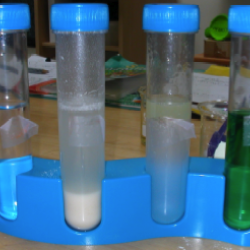Source Institutions
Source Institutions
Add to list Go to activity
Activity link broken? See if it's at the internet archive

In this chemistry investigation, learners combine common cooking substances (flour, baking powder, sugar, salt, pepper, oil, water, food coloring) to explore mixtures. Both homogeneous (whole thing looks the same) and heterogeneous (looks different in different sections) mixtures are created. Static electricity is used to separate salt from pepper. Soap is used to make oil and water mix. Baking powder (an inhomogeneous mixture) is mixed with water to produce a gas. The activity was designed as a kit that could be checked out of a library, but can be done without the kit.
- Under 5 minutes
- 10 to 30 minutes
- $10 - $20 per student
- Ages 4 - 8
- Activity, Experiment/Lab Activity
- English
Quick Guide
Materials List (per student)
- 1 bottle of salt
- 1 bottle of soap
- 1 bottle of pepper
- 1 bottle of oil
- 2 pieces of wax paper
- 1 bottle of food coloring
- 1 sugar cube
- 1 paper plate
- 1 lipstick
- 4 plastic test tubes w/ caps
- 1 balloon
- water (hot and cold)
- flour
- notebook and pen/pencil
- 1 pipette
- 2 teaspoons of baking powder
- ingredients for muffins (optional)
Subjects
-
Physical Sciences
-
Electricity and Magnetism
- Electric Charges and Currents
-
Chemistry
- Chemical Reactions
- Solutions
-
States of Matter
- Solids
- Liquids
- Gases
- Changes of Phase
-
Structure and Properties of Matter
- Atomic Structure
- Elementary Particles and Nuclear Physics
-
Electricity and Magnetism
-
The Nature of Science
-
The Scientific Process
- Asking Questions
- Conducting Investigations
- Gathering Data
- Formulating Explanations
- Communicating Results
-
The Scientific Process
Informal Categories
- Food and Cooking
Audience
To use this activity, learners need to:
- see
- see color
- touch
Learning styles supported:
- Uses STEM to solve real-world problems
- Involves hands-on or lab activities
Other
Components that are part of this resource:
This resource is part of:
Access Rights:
- Free access
By:
- Shaw, Maisie ; Gomez, Maria
Rights:
- All rights reserved, Passport to Chemistry Adventure Program, Mount Holyoke College, 2010
Funding Source:
- Camille and Henry Dreyfus Foundation, Inc.
